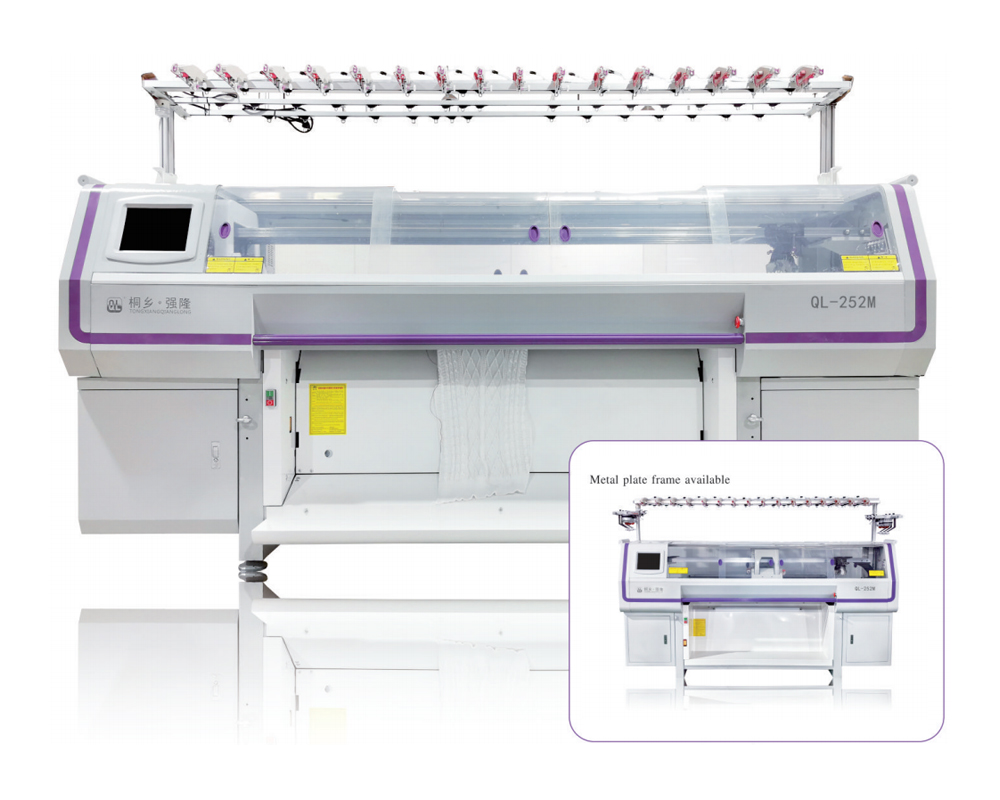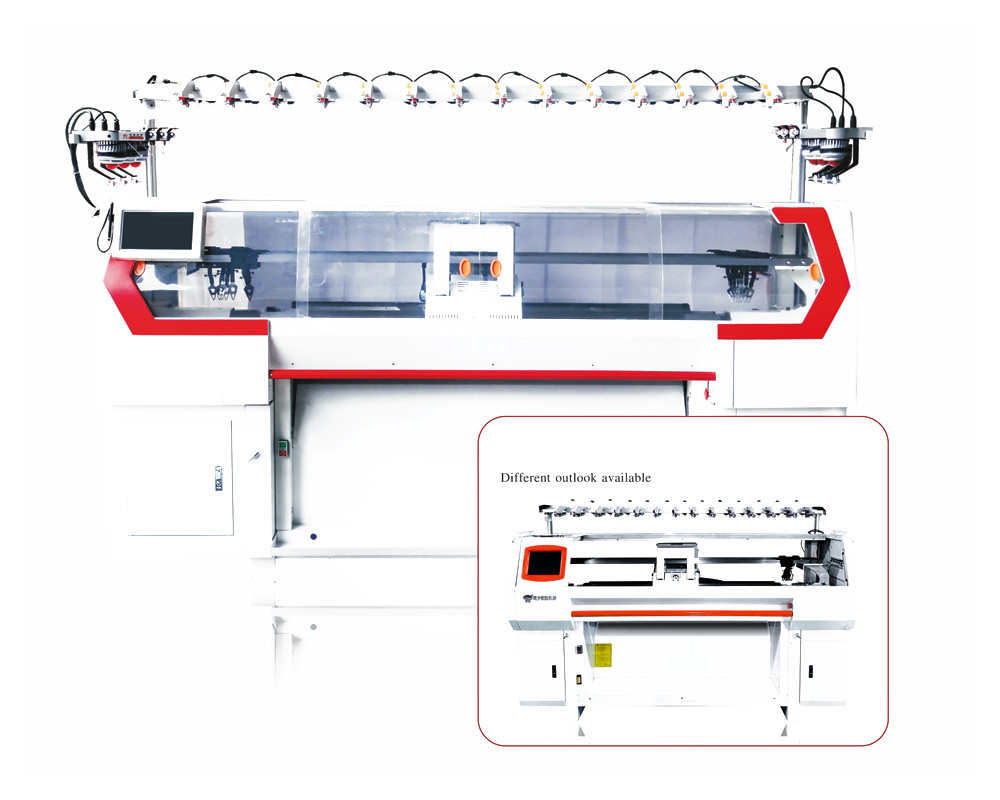Tongxiang Qianglong Machinery Co., Ltd. is high-tech China wholesale computerized flat knitting machine manufacturers, specialized in designing, developing, and manufacturing Knitting Machinery..
Overview: What Makes a Flat Knitting Machine “Smart”
A smart running computerized flat knitting machine combines traditional flat-knitting mechanics with advanced electronics, sensors, and software to automate processes, improve fabric quality, and reduce downtime. “Smart” implies real-time monitoring, adaptive control, network connectivity, and user-friendly interfaces that let manufacturers move from reactive troubleshooting to proactive production management. These features apply across single- and double-bed machines and are especially valuable in high-mix, low-to-medium volume knitwear production where speed, accuracy and flexibility matter.
Automation and Motion Control
Precise drive and carriage control form the backbone of smart flat knitting machines. Modern systems use encoder feedback, servo motors, and closed-loop motion control to coordinate carriage travel, needle selection and yarn feeders. This leads to repeatable pattern execution at higher speeds and with fewer miss-knit events.
Servo Drives and Closed-Loop Feedback
Servo motors with closed-loop feedback provide smooth acceleration/deceleration, minimize mechanical shock, and maintain stitch density across variable speeds. This results in consistent fabric hand and reduces needle breakages caused by sudden carriage stops or overshoot.
Automatic Tension and Yarn Control
Automated tensioners and yarn-feed motors actively adjust yarn payout for each yarn position to achieve stable stitch formation. Smart machines often include yarn clamps and dynamic let-off systems that react to yarn type and knitting speed, reducing defects such as loops, floats or slack stitches.
Sensors, Diagnostics, and Real-Time Monitoring
Smart machines deploy an array of sensors to monitor mechanical and material conditions. The sensor suite typically includes yarn break detectors, needle-status sensors, stitch-formation detectors, tension sensors, and even optical inspection modules for real-time defect detection. These inputs feed into diagnostic systems that alert operators or automatically pause the machine when anomalies occur.
Predictive Maintenance and Alarm Systems
By logging vibration, motor current, and cycle counts, the machine can predict when parts such as bearings or drive belts will fail. Predictive maintenance reduces unscheduled downtime by scheduling service before catastrophic failures, and multi-level alarms guide operators to the likely cause and corrective action.

Software, Patterning and Connectivity
The software stack on a smart knitting machine is a major differentiator. It includes pattern compilers, machine controllers, recipe management, and connectivity modules (Ethernet/Wi-Fi/Industry 4.0 protocols). Modern GUIs allow touch-screen operation, interactive simulation of patterns and direct importing of CAD/graphic files.
Pattern Simulation and Error Checking
Pattern simulation visually previews needle selection and garment panels, allowing designers and technicians to catch programming errors before knitting. Built-in error checking validates loop counts, yarn sequences and tension profiles, reducing material waste from misprogrammed jobs.
Cloud Connectivity and Production Analytics
Cloud connectivity enables remote monitoring, centralized recipe deployment, and production analytics. Managers can track uptime, yield, and quality KPIs across multiple machines or sites. Analytics can reveal bottlenecks—such as frequent yarn breaks on a specific yarn brand—so teams can act on data instead of intuition.
Mechanical Design, Needle Systems and Yarn Handling
Smart machines often pair their electronics with advanced mechanical elements—precision cams, improved needle beds, modular feeders and quick-change components that reduce setup times. Needle systems (e.g., compound needles, hook designs) are optimized for modern high-speed operation and varied yarn counts.
Feeder Modularity and Quick Change
Modular feeders allow rapid reconfiguration for multi-color jacquard, plating, or specialty yarns. Quick-change feeder modules minimize setup downtime and allow operators to swap yarn feeders without disassembling the carriage—critical for small-batch or customized production runs.
Quality Control Features and Inline Inspection
Inline quality control is central to smart knitting. Optical inspection cameras, laser width sensors, and stitch-count verification detect color shifts, dropped stitches, and gauge inconsistencies. When defects are detected, the machine can pause, mark the fabric position and allow for targeted rework rather than scrapping large sections.
- Automatic defect marking and reporting for traceability.
- High-resolution imaging for fine gauge fabrics and complex patterns.
- Integration with post-knit inspection stations to create a continuous quality loop.
Energy Efficiency, Waste Reduction and Sustainability
Energy-efficient motors, regenerative braking systems and smart idle modes cut power consumption. Precise yarn control and pattern validation reduce yarn waste and rejected panels. Some manufacturers also support recycling programs for waste yarn and emphasize compatibility with blended yarns that include recycled fibers.
Safety, Ergonomics and Operator Experience
Smart machines incorporate safety interlocks, soft-stop functions, and clear human-machine interfaces that reduce operator error. Ergonomic feeder heights, tool-less access panels, and clear visual guides shorten training time and make it easier for operators to maintain consistent output across shifts.
Comparison Table: Core Feature Checklist
| Feature | Benefit | Why It Matters |
| Servo motion control | Precise carriage movement | Improves stitch accuracy and reduces needle wear |
| Yarn sensors | Immediate break detection | Prevents wasted fabric and reduces rework |
| Inline camera inspection | Real-time defect spotting | Enables targeted correction and traceability |
| Cloud connectivity | Remote monitoring & analytics | Optimizes production across multiple sites |
Purchasing Considerations and Return on Investment
When evaluating machines, consider not only headline speed but also changeover time, software maturity, after-sales support, and upgrade paths. A smart machine with fewer manual interventions often yields faster ROI through better yield, lower rework, and less skilled-labor dependence. Total cost of ownership should include software licenses, connectivity fees, spare parts and training.
Conclusion: Integrating Smart Features for Competitive Advantage
Smart running computerized flat knitting machines combine mechanical refinement with electronics and software to deliver higher quality, more predictable output and measurable efficiency gains. For knitwear manufacturers, the decision to adopt smart machines should align with product mix, throughput goals, and digitalization strategy. Properly implemented, these machines turn data into action—reducing waste, shortening lead times and enabling more flexible, customer-focused production.

 English
English 简体中文
简体中文
 Chinese
Chinese English
English











